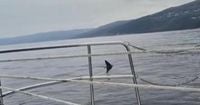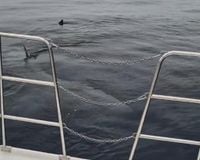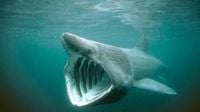A basking shark was filmed off the coast of Croatia on April 13, 2025, captivating viewers with its majestic presence. The sighting occurred a few hundred meters from the shore in the Kvarner Bay, where a fisherman named Cali Mero from Rijeka documented the encounter from his boat. The video shows the enormous shark circling the vessel, offering a rare glimpse into the life of these gentle giants.
The basking shark, scientifically known as Cetorhinus maximus, can grow up to 12 meters in length, making it the second-largest shark species in the world, surpassed only by the whale shark. Weighing up to four tons, these creatures are known for their docile nature, primarily feeding on plankton. Marine biologist Pero Ugarković confirmed the shark's identity, stating, "Basking sharks are completely harmless to humans and are peaceful creatures that feed exclusively on small organisms like plankton and tiny crustaceans."
Interestingly, sightings of basking sharks near coastal areas have become more frequent, raising questions about their behavior and habitat. Experts suggest that this shift may be linked to several ecological and climatic factors. The warming of the oceans has a significant impact on the distribution of plankton, which is the main food source for basking sharks. As nutrient-rich waters warm, plankton blooms often occur closer to the shore, attracting the sharks.
In addition to the changes in food availability, protection measures in various regions have contributed to safer habitats for basking sharks. With reduced fishing and bycatch in certain areas, these gentle giants are more likely to venture into their natural coastal environments. Furthermore, basking sharks are known for their migratory behavior, and coastal regions may serve as stopovers or even mating and breeding grounds.
The footage of the basking shark has sparked excitement and curiosity among viewers, with comments flooding social media platforms. Many expressed awe at the sighting, with remarks like "What a beautiful beast!" and "I would probably have a heart attack if I saw it up close!" The video was shared by Ugarković in the Facebook group "Živi svijet Jadranskog mora" (translated: "Living World of the Adriatic Sea"), where it quickly gained traction.
Despite their massive size, basking sharks are often misunderstood. While their sheer scale can evoke fear, they pose no threat to humans. Instead, they are known for their unique feeding method: swimming with their mouths wide open to filter plankton from the water. This process allows them to filter up to 1.5 million liters of water per hour, showcasing their efficiency as filter feeders.
Historically, basking sharks have been sighted in various locations, with recent encounters highlighting their presence in the Adriatic Sea. In March 2024, an eight-meter-long basking shark was spotted in the Gulf of Trieste, and earlier in December 2024, another large specimen was filmed off Medveja. These occurrences underline the importance of marine conservation efforts, as basking sharks are listed as a vulnerable species on the IUCN Red List.
The increased visibility of basking sharks in coastal areas is not only a boon for marine enthusiasts but also a reminder of the ongoing changes in marine ecosystems. As climate change continues to affect ocean temperatures and food sources, the behavior of marine species like the basking shark may evolve in response. Observing these changes can provide valuable insights into the health of marine environments.
As the world becomes more aware of the significance of marine conservation, sightings like the one in Croatia serve as a powerful reminder of the beauty and fragility of our oceans. Basking sharks, with their gentle demeanor and impressive size, are emblematic of the wonders that lie beneath the surface of our seas. Their presence in the Adriatic not only captivates the imagination but also emphasizes the need for continued protection and respect for marine life.
In summary, the recent sighting of a basking shark off the Croatian coast highlights the changing dynamics of marine life in response to ecological factors. With the warming of seas and enhanced protective measures, these magnificent creatures are increasingly found in coastal regions, offering unique opportunities for observation and education. As we continue to explore and understand our oceans, each encounter with a basking shark adds to the narrative of conservation and the importance of preserving marine biodiversity.










